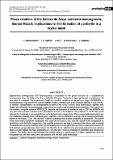Por favor, use este identificador para citar o enlazar a este item:
http://hdl.handle.net/10261/173412COMPARTIR / EXPORTAR:
 SHARE SHARE
 CORE
BASE CORE
BASE
|
|
| Visualizar otros formatos: MARC | Dublin Core | RDF | ORE | MODS | METS | DIDL | DATACITE | |

| Título: | Phase relations in the Cabeza de Araya cordierite monzogranite, Iberian Massif: implications for the formation of cordierite in a crystal mush |
Autor: | García Moreno, Olga CSIC ORCID; Corretgé, L. G.; Holtz, F.; García-Arias, M.; Rodríguez, C. | Palabras clave: | Monzogranites experimental petrology Pseudosections Peritectic Cordierite |
Fecha de publicación: | 2017 | Editor: | Universidad de Barcelona | Citación: | Geologica Acta 15(4): 337-360 (2017) | Resumen: | Experimental investigations and thermodynamic calculations of the phase relations of a cordierite-rich monzogranite from the Cabeza de Araya batholith (Cáceres, Spain) have been performed to understand the formation of cordierite. The experiments failed to crystallize cordierite in the pressure range 200-600MPa, in the temperature range 700-975ºC and for different water activities (melt water contents between 2 and 6 wt.%). In contrast, clinopyroxene and orthopyroxene (absent in the natural mineral rock assemblage), together with biotite, were observed as ferromagnesian assemblage in a wide range of experimental conditions. Thermodynamic calculations, using the software PERPLE_X, describe the formation of cordierite only at 200 and 400MPa and very low water contents, and the amount of cordierite formed in the models is always below 3.5 vol.%. The results indicate that cordierite is not in equilibrium with the bulk rock compositions. The most probable explanation was that cordierite nucleated and crystallized from a melt that is not in equilibrium with part of the mineral assemblage present in the magma. This “non-reactive” mineral assemblage was mainly composed of plagioclase. The silicate melts from which cordierite crystallized was more Al-rich and K-rich than the silicate melt composition in equilibrium with the bulk composition. One possible process for the high Al content of the silicate melt is related to assimilation and partial melting of Al-rich metasediments. An exo-perictetic reaction is assumed to account for both textural and geochemical observations. On the other hand, hybridization processes typical for calc-alkaline series can also explain the high proportions of “non-reactive” minerals observed in relatively high temperature magmas. This study clearly demonstrates that silicate melts in a crystal mush can depart significantly from the composition of melt that should be in equilibrium with the bulk solid assemblage. | Versión del editor: | http://dx.doi.org/10.1344/GeologicaActa2017.15.4.6 | URI: | http://hdl.handle.net/10261/173412 | DOI: | 10.1344/GeologicaActa2017.15.4.6 | Identificadores: | doi: 10.1344/GeologicaActa2017.15.4.6 e-issn: 1696-5728 issn: 1695-6133 |
| Aparece en las colecciones: | (CINN) Artículos |
Ficheros en este ítem:
| Fichero | Descripción | Tamaño | Formato | |
|---|---|---|---|---|
| cabearaya.pdf | 3,49 MB | Adobe PDF |  Visualizar/Abrir |
CORE Recommender
SCOPUSTM
Citations
3
checked on 11-abr-2024
WEB OF SCIENCETM
Citations
1
checked on 17-feb-2024
Page view(s)
151
checked on 22-abr-2024
Download(s)
110
checked on 22-abr-2024
Google ScholarTM
Check
Altmetric
Altmetric
Este item está licenciado bajo una Licencia Creative Commons

